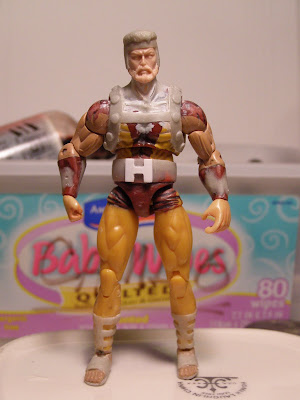
Hey All!
Welcome to my custom figure painting tutorial. Thank you for your interest. The subject of this tutorial is my new Marvel Universe Hercules custom. I decided to do the Lion of Olympus in his garb from his mid to late 80's stint on the Avengers roster. The part list are as follows:
His head is a modified Broken Arrow Toys head
His body is an MU Wolverine
His hands are from the Submariner
His Feet are From an Indiana Jones Ugha Warrior figure
The H on his belt is cut from thin sheet styrene
His Mace is cobbled together from parts of a Black Panther Katana and a Transformers Missile
The garish forward poised Wolverine neck was removed and replaced with a GI Joe Classics Zartan neck.
All of the sculpting was done with Aves Apoxy Sculpt and thoroughly sanded smooth after each application.
Now on to the painting. The largest portion of this figure is flesh tone so I mix up a big batch. This consists of 4 colors in this particular case and they are flat yellow, and 3 flesh tones: base tone, shade tone, and highlight tone. The flat yellow is Tamiya brand and the 3 flesh tones are Testor's Model Masters. I mix the desired color on a plastic plate that serves as a great

disposable palette and I thin it with water to the consistency of milk. This is vitally important as it is imperative to apply the paint in many thin, smooth coats until desired coverage is attained. If the paint is applied to thick it will cause brush strokes and in extreme cases clumping.
The best way that I can describe the process of painting with many thin coats is that rather than brushing on the paint it is necessary to
float the paint on with the brush. Move it around gently and smooth out the puddles with the brush. When the first coat is dry you can begin to apply the second, third and so on. You should
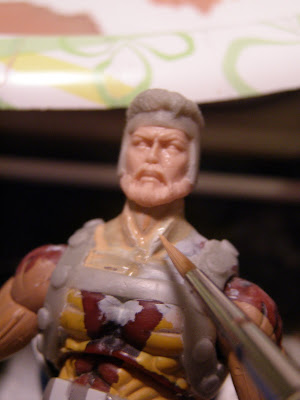
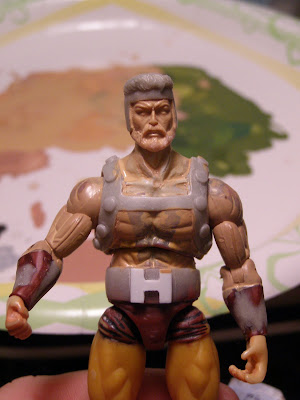
expect that at the right consistency it might take up to 6 or 8 coats to completely cover the figure. While this sounds like a tedious process, the results are worth the work. Take note of the picture in which the paint is being applied to the neck of the subject and note how thin it is. Then notice the photo of the dried first coat on the head, torso, and arms of the subject and take note of the thin wisp of coverage. This is what you should expect to achieve after one coat. Again, patience and persistence will produce the best possible results here. Be sure to continue to thin your paint with water as needed and be careful not to reactivate dried portions of the paint on the palette as this may cause you to apply clumps of dried paint to your subject that might not appear visible until the coat is dry.
After several coats of flesh and a green mixed with Testor's magical blue and Tamiya flat yellow the upper torso has been sufficiently covered. Note that at this stage neatness is not paramount. I am more concerned with smooth even coverage and I am aware that touch ups and tightening are necessary. (see below)

I remove the Lower legs and paint the tops of the thighs as well as the inside of the hip where the top of the leg is going to rub within the waist at the pint of articulation. This will ensure that there is no paint rub on the hip joints. Paint rubbing
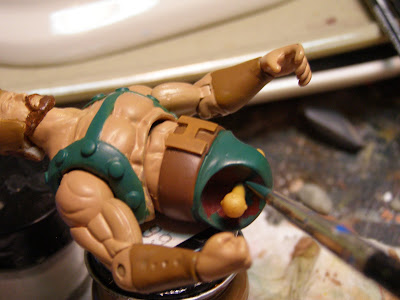
against raw plastic will cause paint rub, but paint against paint (especially the same color) should not produce ware. (see image below)

Once the figure has been completely base coated you can begin to work the details like eyes and eyebrows. I wish I could say that there is a special trick to doing these kinds of minute details skillfully. If there is, I am unaware of it. it simply takes patience, a steady hand, the right tools, and practice. First be sure to keep the paint thin as always. Thin down the white to the consistency of milk, load up a detail brush with the thinned paint, run off any excess paint on your palette while pointing the
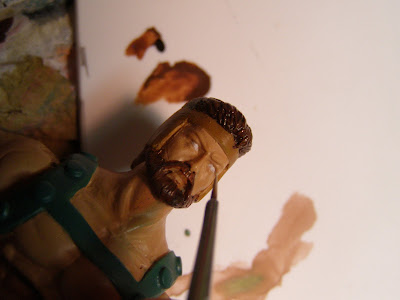
brush and gently float the color onto the eyes. The watery paint should find it's level and of you have a crisp sculpt it will fill the socket to the lids. Don't worry if the white leaks out over the eye lids a bit... touch ups are inevitable and necessary. Next, choose your desired color for the pupils and thin this down appropriately. For this you want to make sure that only the tip of the brush has paint on it so brush off any excess on your palette and make sure you point the brush while doing so. Carefully paint in the pupils on both eyes making sure that they are even and equal in size. I usually leave a bit of white space under the pupil . It sometimes has the affect of the figure looking up a bit, but it cuts down on the blank stare look that sometimes occurs when the pupil fills the eye from lid to lid.

The next step is to take some thinned brown paint and line the upper eyelid with it. This is probably the most difficult and frustrating part of the painting of the eyes, but it is necessary to achieve realism. The line can and should be touched up with the flesh tone and the pupil with the white, etc. to tighten all of this up. Again, the important thing to remember is to keep the paint the thin so that no matter how many coats you have to layer in touch ups you don't get any clumps or unwanted build up. Be patient and be careful and you'll do fine.

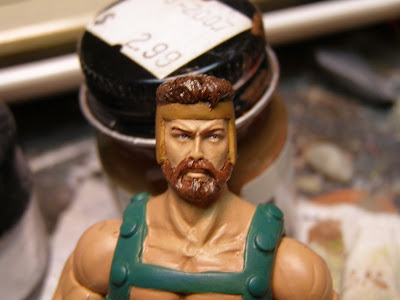
Once everything is touched up and tightened to your satisfaction you can paint in the eyebrows using the same basic rules. Remember, don't worry if you don't get it perfect the first try (I NEVER do). Painting is all about painting a line and then painting it back. In other words pain the line and then sharpen and tighten it by painting it back with the flesh tone. If your paint is properly thinned you should be able to repeat this process over and over without nasty build up or clumping.

Once the details are completed I give the entire figure (the legs still seperated from the hips) a generous coat of Testor's Dullcoat. The reason for this is threefold. First, some of the paints that I mixed together have a bit of a sheen to them and I want a nice even finish on the figure before I begin shading. Secondly, I want to make sure that the joints are fully sealed and protected before I bend them to expose the unpainted portions. Once the figure has completely cured (after several hours or even over night) I will bend the joints and paint the previously unexposed portions and seal those areas accordingly. Thirdly,
pastel dust will not stick to
ANY glossy surface so the application of the Dullcoat is actually a preparatory step for the shading. What is pastel dust, you ask? Read on....
If there is a trick to my technique of painting figures, this is it. Pastels are an artists drawing medium which is sort of like a stick of richly colored pigment that resembles a piece of chalk. They are most commonly found in stick form either round or squared, but can also be purchased jarred in a powdered form. They are available in an infinite variety of rich colors and can be found in most hobby, craft, or art stores. While this medium is most commonly used for drawing and painting, custom modelers have been using them for years to weather, age, or rust their subjects. The earth tone pastels used for this kind of

effect are sometimes packaged and found at model train shops labeled as "weathering pastels". The earth tones found in these kinds of boxed sets are an excellent variety for shading flesh, but you may want to purchase some other colors for the purposes of shading other portions of your figures like clothes, armor, boots, etc.
For the flesh tone on Herc I'll be using a Burnt Sienna colored pastel that I have in powdered form almost exclusively with the exception of a little red that I have in stick form (the photo where I am scraping the red stick with a piece of glass llustrates how i turn stick for into powder in order to apply it) to warm up the lips, cheeks, and other hot spots on the body. I start by

dumping a bit of the powder on to a sheet of paper and loading up a brush... a very cheap brush, mind you... pastel dust eats brushes like hydrochloric acid. You definitely don't want to use your best brushes to apply pastel dust. So... load up your cheapo brush with the Burnt Sienna (which is a deep reddish
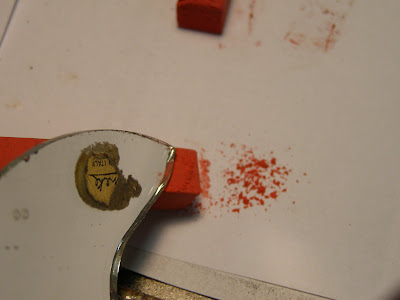
brown color) and begin rubbing the powder into the recesses of th face. As soon as you touch the brush to the figure powder
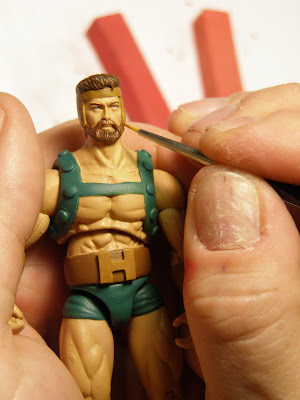
is going to burst out all over the place. Don't panic just rub the brush into the recessed areas (the eye sockets, ears, laugh lines) and under the cheek bones, etc. Simply

blow the excess powder off, reload the brush and get back to it. Continue to build up the shading in the recesses until it seems like the powder isn't sticking anymore then move on to the neck and body. Build up the shading slowly and try not to over do it. Subtlety is the name of the game. Do not touch the completed portions of the shaded figure with ANYTHING other

than the brush! You will permanently ruin any area that you smudge. I shaded the entire head and upper torso while holding the legs. Once the upper torso, arms and head were complete I sprayed the shaded areas with a generous helping of Dullcoat

to seal it. The photo taken out doors illustrates the completed, sealed upper body with the untouched legs as a comparison. At this stage I need to decide whether or not to go back in and add another layer of shading or let it go the way I have it. I decide to let subtlety win out and I move on to the legs.


Once the entire figure has been adequately shaded it is completely coated in Dullcoat to seal it and it is allowed to cure overnight. this should create a solid barrier of sealant to protect your work.
While this may seem an unorthodox way of working I think that once you get the hang of it not only will you find the results to be far superior to other conventional shading techniques like washing and dry brushing, but I think you will also find the application to be far easier. I suggest trying it on minor areas like boots or accessories before trying to tackle an entire figure. Have fun and feel free to contact me with questions.
I hope that this tutorial has been informative and useful. Thanks for your interest and attention!

